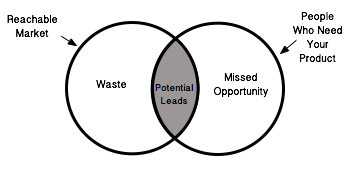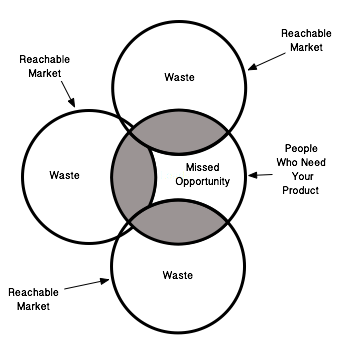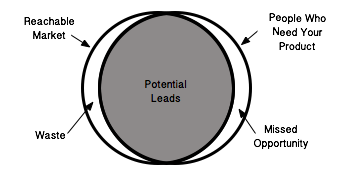As John Wanamaker said nearly 100 years ago, "Half my advertising budget is wasted; the problem is that I don't know which half." Today, with all the options available for marketing and promotion, and all the clutter in the media, it's easy to waste your entire marketing budget - and quickly go out of business.
Consider the typical business-to-business (B2B) marketing program today that might include telemarketing, email, pay-per-click (PPC), trade shows, networking, direct mail, Search Engine Optimization (SEO), Inbound Marketing, Search Engine Marketing (SEM), Social Media Marketing (SMM), Public Relations (PR), channel partners and advertising - which is an enormous and expensive arsenal to begin with.
By definition, each of these promotional strategies entails some investment (e.g. dollars, time, effort, etc.), and each expects some result (e.g. clicks, responses, leads, opportunities, sales, etc.). Therefore each should generate an ROI, calculated (roughly) by putting a value on the result and dividing it by the investment, shown below:

The problem is that each marketing strategy inevitably has some waste in it. And waste drives down your ROI. So you have to work aggressively and deliberately to eliminate it in order to maximize your marketing ROI.
| Promotional Strategy | Sources of Waste |
| PR, Inbound | Clutter |
| Telemarketing | Calling companies that don't have an application |
| Spam filters and abuse honeypots | |
| Pay-per-click | Tire-kickers, bots, competitive bidding |
| Trade shows | Unqualified traffic |
| Networking | Other people trying to sell to you |
| SEO | Search term mismatch, competitive ranking |
| Social Media | Participation of non-buyers |
| Advertising | Irrelevant eyeballs |
| Channel partners | Conflicting partner priorities |
| Direct mail | Envelope sniffing |
| IP Tracking | Dynamic IPs, inability to identify visitor |
| Search Marketing | Click fraud |
The Inevitability of Waste
For most companies, the problem of waste first surfaces when they try to improve the ROI of their marketing program. For most companies, this effort at improvement typically fails, and costs often go up, or results go down.
The first reason that efforts to improve Marketing ROI typically fail is because most people usually just swap one strategy for another, hoping that it reduces waste and works better. But that approach generally just trades one marginally effective promotional technique for another.
The main reason that most efforts to improve Marketing ROI actually fail is because most people don't understand how the ROI formula actually works, and therefore they try to fix the wrong thing. Specifically, most people either focus on growing the numerator (e.g. getting more clicks, hits or leads), or reducing the denominator (i.e. reducing the effort, time or expense). But this simplistic approach ignores some fundamentals of marketing. And therefore it ignores the greatest opportunity for improving ROI: reducing waste.
In marketing, "waste" has a very specific definition. "Waste" in marketing is paying to promote your product to people (or companies, in the case of B2B) who either can't or won't buy it. Think of cold calling companies who don't have an application for your product. Or showing your banner ad to non-users. Or generating clicks where you can't identify the visitor. Or sending emails that get trapped by spam filters. Each inappropriate dial, exposure, view, and send is wasted. And each drives down your ROI because you're paying for something you don't need, and from which you can't possibly benefit.

How Waste Reduces Your Marketing ROI
To be sure, some waste may be unavoidable, as we've been told by advertising agencies for generations. "You have to buy the whole issue to get to the exposures that you really want," they typically say. And for many media, it's often true.
Think of exhibiting at a trade show that has low attendance. Wasted, but for the few people who mattered. Or advertising on a Web site that your prospects visit, but so do many other people. Or having to buy a minimum number of email addresses or contact records, knowing that many - if not most - are bad. Some waste can't be avoided, at least given the tools provided by most media. But it's waste nonetheless, and it drives down your Marketing ROI, often significantly.
In general, most marketers are aware of the waste issue, and they try to solve it by paying as little as possible for as much exposure as possible. But this is exactly the wrong solution because it accepts waste as a given rather than the controllable variable that it really is, despite what the vendors say. And as a result, ROI often goes down, not up, when you try to save money on marketing.
The first reason this happens is because most marketers decide their media mix under the assumption that whatever waste exists in any given strategy is fixed when, in fact, it isn't. Often that perception is the result of a business decision by media provider regarding how they want to package their offerings. But with today's technology you don't have to be victimized in this way. Deliberately spending money to minimize waste (rather than simply to reduce costs) can pay for itself. In fact, doing so can even shift ROIs in such a way as to make formerly uneconomic strategies worth doing.
The other, and far more significant, reason lies in the fact that most marketing programs target prospects based on demographics such as what industry they're in, what sites they visit, their size, or where they're located. The problem is that what you, as a potential vendor, would really like to do is target prospects based on their "needs", not their demographics. That is, does the prospect have a specific and relevant need or problem that your product can solve, and that they want to solve?
Demographics are often extremely poor indicators of need, however. And using them actually makes targeting in this way the most significant, expensive and ultimately unnecessary source of waste.
This concept is illustrated in this simple Venn diagram:

The Origin of Waste in Marketing
As you can see in the diagram above, the left circle represents those people whom you can "reach" (i.e. get your message in front of) with whatever marketing communications tools you're considering. This is called the "Reachable Market." It might be users of LinkedIn, attendees at a trade show, people whose email addresses were harvested by a list vendor, visitors to a site sponsored by the pay-per-click company, or companies with a particular SIC Code on a purchased list. Some of these people might have a need for your product, of course, but others will not.
As a marketer, you then plan your campaign hoping that enough of the Reachable Market has a relevant need or problem to make the investment worthwhile. And such a hope can often be justified if the cost, including waste, is low enough. So while the effect of waste on ROI may be negative, it may be tolerable in the overall calculation.
Obviously what you really want is to target only those people or companies in the right-hand circle - those with an actual, or at least latent, need for your product. The problem is that if the tools you're using don't reach them, these people become "missed opportunity." And they therefore can't provide a return. In fact, it may be worse than that; this missed opportunity may actually be contributing to your competitor's ROI because you missed them.
The natural response, of course, that most marketers have to this situation is to double down on the strategy. That is, they implement additional marketing communications strategies, and buy additional media, hoping to minimize the amount of missed opportunity, as shown in the diagram below.

Doubling Down
As you can see, leveraging whatever reach is available with this strategy makes some sense because it maximizes market coverage, but it does so at the cost of maximizing waste too. And so the impact on ROI is, at best, neutral (assuming waste is only additive). But the impact is more often highly negative.
One reason it often has a net negative impact is that each promotional strategy you add will generally have less opportunity and more waste in its reach than the last. Otherwise you would have chosen that strategy sooner. And while the benefit of the repetition effect could compensate, there is often more repetition in the waste than in the opportunity. And so the net result is a lower ROI.
And arguing that the more complete coverage makes up for the ROI decline doesn't help. If marketing is budgeted based on a fixed percentage of sales (rather than on ROI), then this strategy simply puts more pressure on your overall operating or sales margin by adding more cost, with an increasingly lower benefit.
As you can see, the real problem here is waste. Marketing to people who don't need your product wastes time, money and effort. It uses resources that would be better expended elsewhere. And it dilutes your message intended for those people you most need to hear it. Simply put, if you want to improve results, you have to spend money to eliminate waste.
The classic method for eliminating waste, of course, is market research, of which there are several types that we'll talk about in a moment. Unfortunately, market research is a tool that, for most B2B companies, has fallen so out of favor as to be nearly radioactive. It's viewed as a waste of money by product managers who believe they know their market's needs. It's viewed as a waste of time by marketing managers who are under pressure to get their message out as soon as possible. And it's viewed as frivolous by sales managers who want leads, not "information."
But just as ignoring waste represents a profound misunderstanding of the Marketing ROI calculation, dismissing market research as the solution represents a profound misunderstanding of the marketing and sales processes, as well. A simple thought experiment illustrates why.
Suppose you had a system that is intended to help banks operate more efficiently, particularly the 10% of the banks that use a specific business process. If you're like most companies, one of the first things you'll do is buy a list of banks, and call them. You'll ask each if they have this particular process. And then you'll try to persuade those that do to buy.
As you can see in this instance, 90% of these calls were clearly wasted. If you had known ahead of time which ones used the process, of course, you would have focused on them, and ignored the others. And you would have been able to reduce your marketing expense by 90%. (We're estimating here.) But you didn't, so you wasted 90% of your budget.
Obviously, conducting market research (to figure out which banks use the process) would have entailed some cost, and that would reduce the savings somewhat. But how often do you consider market research as an option? And how often do you run the calculation to see if it's worthwhile?
If you're like most people, never.
And that's a huge problem, particularly if you look back at the conventional response to this situation, i.e. "doubling down," by adding more marketing - and more waste - in order to be sure that you find the 10% you're after.
So now, making matters worse is the fact that, of the 10% of the banks that use the process, maybe only half of them actually perceive that there's a problem with it. So now you've wasted another 5% of your marketing budget targeting them, and probably 50% of your sales budget trying to persuade them to buy.
If you don't think waste is the problem at this point, you probably don't really care about ROI. But if you do, we can now talk about solutions.
There are two basic types of market research that you can use to eliminate waste.
Both methods for conducting primary market research are time-tested and conventional, with pre-qualification calls generally being less expensive and faster for supporting current sales (as opposed to new product development, for example, where surveys are considered vital.)
Likewise in the secondary realm, re-purposing surveys is generally more helpful early in the product life cycle. But data mining, enabled by the ocean of information available on the Internet, is invaluable for eliminating waste, improving ROI, and boosting sales.
This is illustrated by the Venn diagram below, which shows the impact on targeting of using MindReader or other similar primary or secondary market research tools.

Reduction in Waste Through MindReader
As you can see, by pre-qualifying suspects using MindReader or some other market research technique, you can significantly reduce waste and missed opportunity, and significantly improve the targeting of your program.
Recent campaigns by JV/M using its MindReader data mining solution, for example, have delivered dramatic improvements in for our clients:
Results like these are not atypical, primarily because of the quality of information that's available through data mining. But it's also because of the magnitude of the waste problem. With the proliferation of marketing solutions today, there is so much waste that you can sometimes trip over a solution simply by looking at the problem.
Data-mining/secondary market research systems like MindReader are based on custom algorithms that are designed to identify qualified prospects (i.e. ones who need your products) in the market. Depending on your market, your product's applications, and what you consider to be a viable prospect, developing a MindReader algorithm can take anywhere from a few days to a few weeks, and can cost anywhere from $10,000 - $30,000. Because of the dynamic nature of the data sources, most algorithms also may require some maintenance, which generally falls in the range of 10% per month.
Linked to lead generation, though, data mining can enable you to rapidly identify and reach highly qualified prospects, often ones who have an immediate and actionable need for your product or service. And it helps you avoid marketing to ones that don't.
As you can see, while the effort is designed to eliminate waste, the result enables you to maximize your Marketing ROI. And it also enables you to maximize your sales, shorten your sell cycle, increase your close rate, and optimize your margins as well.